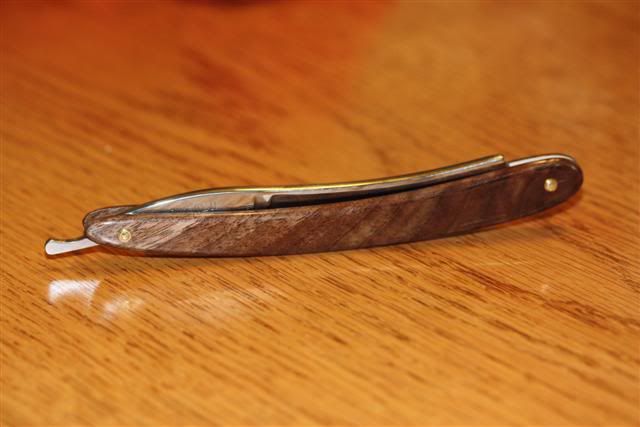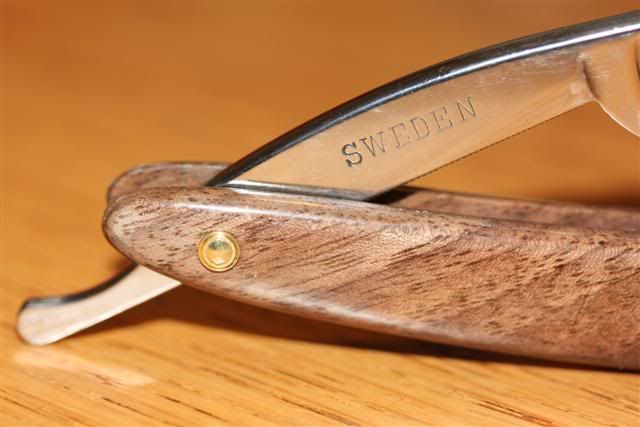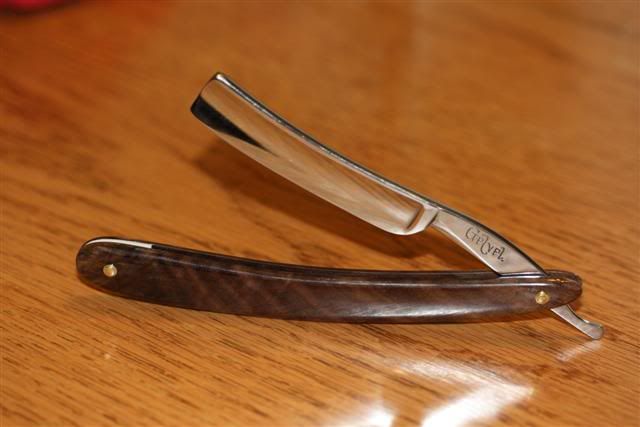Results 31 to 40 of 50
-
03-21-2011, 02:22 PM #31Junior Member

- Join Date
- Mar 2011
- Location
- Rochester NY
- Posts
- 24
Thanked: 3
My first shot at a CA finish. I used a gap filling CA. 4 coats, sand with 400 repeat. After 12 coats sand with 600,800,1500,2000, then turtle wax rubbing compound followed by TW polishing compound.No wax. Came out super glossy.
I used 4 wires screwed to a board with the tips of the wires fitting the holes in the scales to hold them elevated while I applied the CA.




-
03-21-2011, 02:23 PM #32Senior Member


- Join Date
- Jan 2011
- Location
- Roseville,Kali
- Posts
- 10,432
Thanked: 2027
carnauba will waterspot over time,would look into getting some renaissance wax.
-
03-21-2011, 03:06 PM #33At this point in time...




- Join Date
- Jun 2007
- Location
- North Idaho Redoubt
- Posts
- 26,957
- Blog Entries
- 1
Thanked: 13223
I think you could get away with using the Flitz as a cutting compound...
-
03-22-2011, 12:22 AM #34

Thanks Glen for posting this up. I'm planning out some wood scales and was trying to figure out what would be the best finish for a rich deep shine. I can't say I'm 100% sold on this doing what I have in my head, but not knowing about it certainly wasn't going to help!
Am I to understand that this CA Glue is what's in that bottle of Gorilla Glue I have in my garage? Or is it a special type of Gorilla Glue? I've never heard of Califonia Glue (Which is what I take the CA to mean, though I could certainly be wrong).
Also, just to clarify on the Acetone issue, did you use acetone on stained wood?
Thanks!
-
03-22-2011, 12:31 AM #35At this point in time...




- Join Date
- Jun 2007
- Location
- North Idaho Redoubt
- Posts
- 26,957
- Blog Entries
- 1
Thanked: 13223
Cyanoacrylate - Wikipedia, the free encyclopedia = CA
I have never stained any of the wood I use so that you will have to check on ... I guess I am a slight purist in that I like natural wood colors.. let everyone know what happens if you try it though...
-
03-22-2011, 12:36 AM #36

Who knew?
 I guess that's what happens when you assume.
I guess that's what happens when you assume.
You may have just saved me from a huge headache in my first ever re-scale.
If I do stain any wood for scales, I will post results. I may try it anyway, as I'll have some extra material.
Thanks again, Glen.
-
03-22-2011, 12:56 AM #37Junior Member

- Join Date
- Feb 2010
- Posts
- 13
Thanked: 1
As mentioned, you do not have to stain the wood. I am doing my first CA job and the effect on the wood's grain, contrast, etc is more like polyurethane than I expected. My scales are mahogany and are turning out gorgeous from just the CA on there (I have more work to do before sharing pics though...)
However the wedge I am doing in teak, and I hit it with a chestnut stain to really darken it up for extra contrast. I am out of acetone so I used mineral spirits but I think you will see similar behavior (more experienced woodworkers please correct me if I'm wrong!). I think the bottom line is that you want to wipe the wood with acetone, THEN stain, then proceed with your CA. I think if you wipe wood with something to dissolve the oils after the stain is on it then the solvent will pull on the stain and make it uneven or even bare in spots and you will likely have to pull all the stain out and stain it again to get it to look even.
I don't have a lot of experience pulling stain so I may be overstating the effect but I can confirm that if you "wash" then stain you will be OK.
-
06-03-2011, 11:40 PM #38

because I recently did a custom with wood and acrylic I decided to use CA since it will adhere well to both materials and I wanted the finish to be smooth throughout instead of a noticeable seam from wood finish to plastic (also felt this might help strengthen the joint between the materials.
I learned a lot on test pieces before attempting my finish. While the grit suggestions glen gives work very well for the materials I did notice that on the clear acrylic part when held up in the light, scratches from each coat still appear. In this one rare situation where you're putting CA on clear acrylic, I would suggest sanding up to a minimum of 600 grit between coats (800 optimally), this includes the initial coat, to make sure the finish is transparent and without ghost scratches. This is usually a non issue as wood isn't generally transparent.
took me many tests to figure this out, might help someone.
**EDIT**
I would have added this info to a wiki but I couldn't find one specifically on CA glue. I also could not find a definitive answer on how long to wait between coats to make sure the finish is dried and does not cloud on the next layer. Not sure if there's a for sure answer on that one.Last edited by TheBaron; 06-03-2011 at 11:56 PM.
-
The Following User Says Thank You to TheBaron For This Useful Post:
jeness (06-05-2011)
-
06-05-2011, 08:14 PM #39

I have been thinking of what time to finish on a set of wooden sales I am making...this would be great. thank you. I can't contribute on how to apply a nice finish but working with super glue if any one else is like me I seem to get it everywhere or glued to something. A friend told me to clean up with white vinegar, and it works great removing super glue, some epoxy, and varnishes very easily. It's cheap and no harsh chemicals...might be useful to someone else.
-
The Following User Says Thank You to bondpunk For This Useful Post:
BigJim (06-05-2011)
-
05-28-2012, 09:36 PM #40Junior Member

- Join Date
- Jan 2012
- Posts
- 13
Thanked: 3
Not sure if I missed this or if it's just obvious, but how should I apply the CA? Should I drip it on and spread it around and let it puddle up on the wood as it's laying flat, or should I let it drip off (apply holding the pieces vertically)? On my test pieces I've been doing the latter, but I'm only two coats in. I'm using thin CA.


 46Likes
46Likes LinkBack URL
LinkBack URL About LinkBacks
About LinkBacks






 Reply With Quote
Reply With Quote



